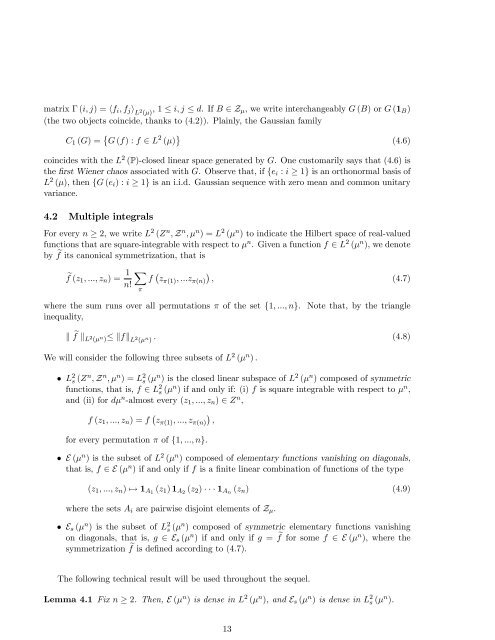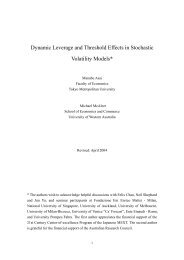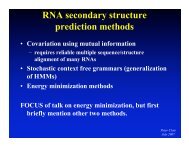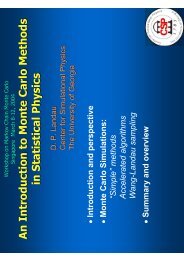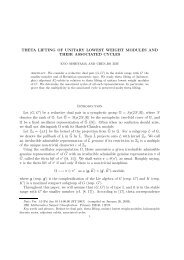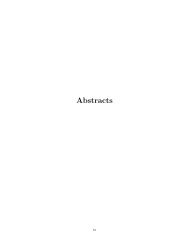Stein's method, Malliavin calculus and infinite-dimensional Gaussian
Stein's method, Malliavin calculus and infinite-dimensional Gaussian
Stein's method, Malliavin calculus and infinite-dimensional Gaussian
You also want an ePaper? Increase the reach of your titles
YUMPU automatically turns print PDFs into web optimized ePapers that Google loves.
matrix (i; j) = hf i ; f j i L 2 () , 1 i; j d. If B 2 Z , we write interchangeably G (B) or G (1 B )<br />
(the two objects coincide, thanks to (4.2)). Plainly, the <strong>Gaussian</strong> family<br />
C 1 (G) = G (f) : f 2 L 2 () (4.6)<br />
coincides with the L 2 (P)-closed linear space generated by G. One customarily says that (4.6) is<br />
the …rst Wiener chaos associated with G. Observe that, if fe i : i 1g is an orthonormal basis of<br />
L 2 (), then fG (e i ) : i 1g is an i.i.d. <strong>Gaussian</strong> sequence with zero mean <strong>and</strong> common unitary<br />
variance.<br />
4.2 Multiple integrals<br />
For every n 2, we write L 2 (Z n ; Z n ; n ) = L 2 ( n ) to indicate the Hilbert space of real-valued<br />
functions that are square-integrable with respect to n . Given a function f 2 L 2 ( n ), we denote<br />
by e f its canonical symmetrization, that is<br />
ef (z 1 ; :::; z n ) = 1 X<br />
<br />
f z<br />
n! (1) ; :::z (n) , (4.7)<br />
<br />
where the sum runs over all permutations of the set f1; :::; ng. Note that, by the triangle<br />
inequality,<br />
k e f k L 2 ( n ) kfk L 2 ( n ) : (4.8)<br />
We will consider the following three subsets of L 2 ( n ) :<br />
L 2 s (Z n ; Z n ; n ) = L 2 s ( n ) is the closed linear subspace of L 2 ( n ) composed of symmetric<br />
functions, that is, f 2 L 2 s ( n ) if <strong>and</strong> only if: (i) f is square integrable with respect to n ,<br />
<strong>and</strong> (ii) for d n -almost every (z 1 ; :::; z n ) 2 Z n ;<br />
f (z 1 ; :::; z n ) = f z (1) ; :::; z (n)<br />
<br />
,<br />
for every permutation of f1; :::; ng.<br />
E ( n ) is the subset of L 2 ( n ) composed of elementary functions vanishing on diagonals,<br />
that is, f 2 E ( n ) if <strong>and</strong> only if f is a …nite linear combination of functions of the type<br />
(z 1 ; :::; z n ) 7! 1 A1 (z 1 ) 1 A2 (z 2 ) 1 An (z n ) (4.9)<br />
where the sets A i are pairwise disjoint elements of Z .<br />
E s ( n ) is the subset of L 2 s ( n ) composed of symmetric elementary functions vanishing<br />
on diagonals, that is, g 2 E s ( n ) if <strong>and</strong> only if g = e f for some f 2 E ( n ), where the<br />
symmetrization e f is de…ned according to (4.7).<br />
The following technical result will be used throughout the sequel.<br />
Lemma 4.1 Fix n 2. Then, E ( n ) is dense in L 2 ( n ), <strong>and</strong> E s ( n ) is dense in L 2 s ( n ).<br />
13


